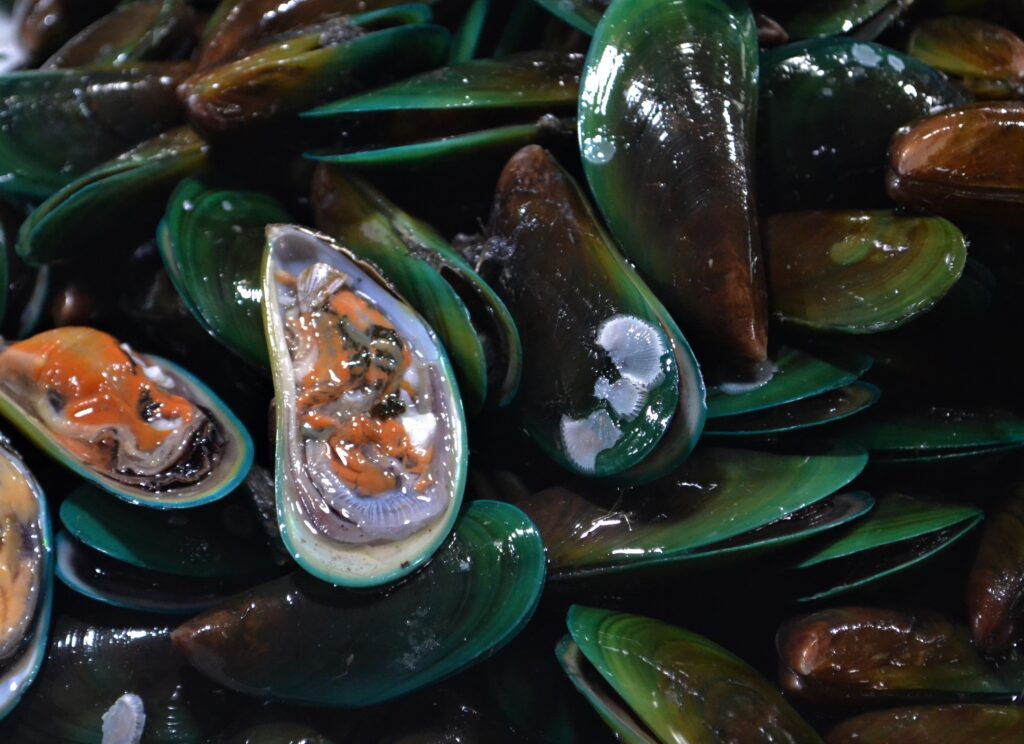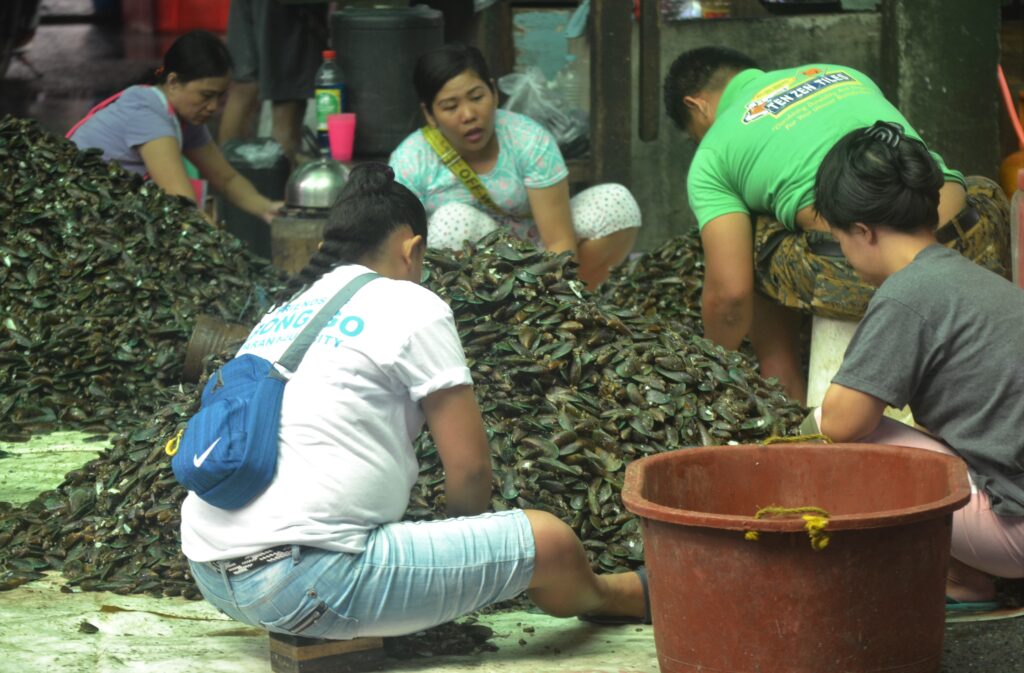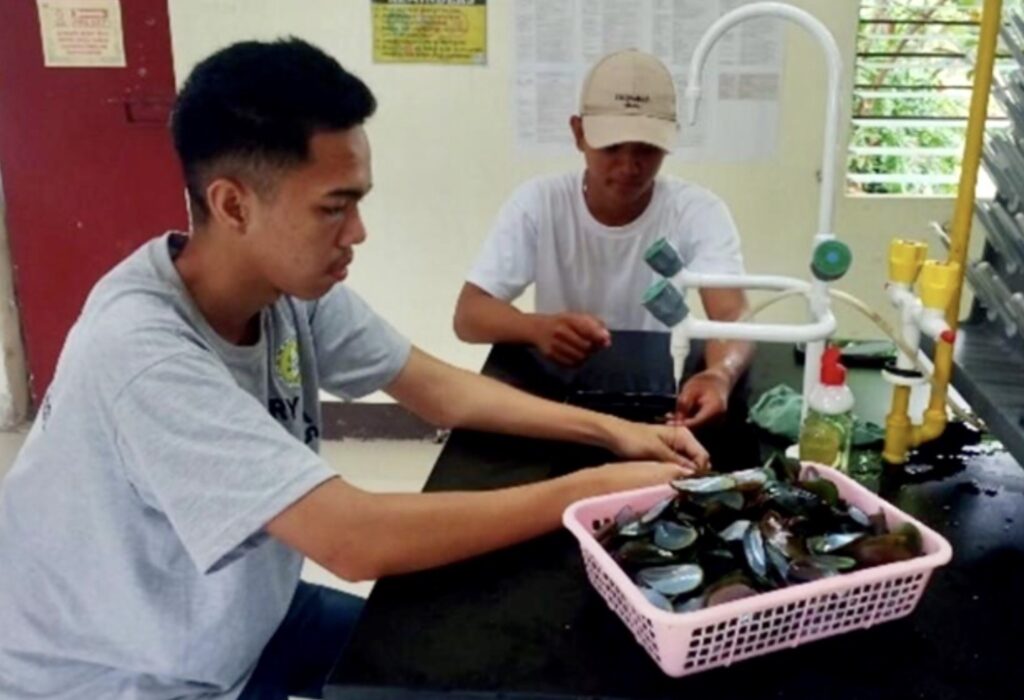By Henrylito D. Tacio

It’s called tahong in Tagalog and amahong in Bisaya. In English parlance, it is mussel, the common name used for members of several families of bivalve mollusks from saltwater and freshwater habitats.
Mussels have been eaten by human beings since time immemorial. About 17 species are edible and those you buy in the markets are green mussels (called in the science world as Perna viridis). Those are farmed while the brown mussels (Modiolus metcalfei) are exclusively gathered from natural beds.
The Food and Nutrition Research Institute (FNRI), another DOST line agency, says mussels are nutritionally rich. They contain 13.6% protein, 11.1% carbohydrates, and 7.5% fats. They are also a good source of calcium, phosphorus, iron, thiamin, riboflavin, foliate, vitamin B12, manganese, selenium, omega 3 and 6, magnesium, potassium, and zinc.
The popularity of mussels has resulted in substantial shell waste. If not addressed soon, another environmental problem may happen. So much so that University of the Philippines Visayas (UPV) launched a project called, “A Valorization of Agri-Fishery Materials Using Opportune Science (AVAMOS): Nanomaterials from mussel shells for agri-aquaculture applications.”
With funding from the Philippine Council for Agriculture, Aquatic and Natural Resources Research and Development (PCAARRD), the project is set to generate mussel shell waste processing innovations that are anchored on green nanotechnology and circular economy.
“Traditionally, mussel processing mostly focuses only on the meat, leaving behind a substantial quantity of shells,” notes Rizza B. Ramoran of Science and Technology Media Services. “However, these discarded shells hold great potential as raw materials for nanomaterial production for application in aquaculture and agriculture.”
Possible uses of mussel shells
Now in its first year of implementation, the project collects discarded food waste from random households in Iloilo province. Procured mussel shells are pulverized and used as nanomaterials that have an adsorption capacity twice over available technologies.
The mussel shells are repurposed and pulverized to serve as valuable resources such as, feedstocks, mulch, aquarium decorations, fertilizers, and other uses. Throughout its implementation, the project is also working collaboratively with various industry partners in achieving its set objectives and deliverables.
With strong and continuous commitment in advancing the mussel industry, the PCAARRD also supports various projects on processing mussels as functional food and mussel biotechnology led by UPV and Capiz State University.
“Aiming to promote sustainability and zero-waste management, the waste mussel shells generated from these projects will be utilized by the AVAMOS project,” Ramoran reported.
One good thing about the innovative waste valorization strategy is that it helps reduce solid waste accumulation in communities and foster a healthier environment.
In addition, the production of these nanomaterials opens doors for the development and commercialization of innovative products with potential economic benefits.
“This initiative is expected to enhance the country’s management of shell wastes and cultivate a deeper sense of environmental stewardship,” Ramoran said. “Most importantly, it ensures that the future commercialization initiatives for technologies that may result from this project would create a positive impact to society, benefiting the environment and the communities relying on the mussel industry.”
What most Filipinos buy in public markets are green mussels since this species can be farmed. The brown mussels can’t be raised as they are not known to attach to ropes or bamboo poles; they are exclusively gathered from natural beds.
“The green mussel industry is a fast-growing industry in the Philippines,” said the PCAARRD, a line agency of the Department of Science and Technology (DOST).
Red tide
In terms of production, one of the drawbacks with mussels is that they are susceptible to harmful algal bloom (HABs), or more popularly known as red tide. “This increased occurrence of blooms may have been brought about by climate change,” wrote Leni Yap-Dejeto in The PCAARRD Monitor.
In Samar of Region VIII, HABs displaced fisherfolk for months with recorded economic losses that can reach P250-million per occurrence of HAB.
People who love to eat mussels must ensure that the mussels they are cooking are alive before being cooked. The enzymes mussels produce quickly break down the meat and make them unpalatable or poisonous after dying or uncooked. Some mussels might contain toxins, the Medline Plus Encyclopedia warns.
“A simple criterion is that live mussels, when in the air, will shut tightly when disturbed,” the ABC Science pointed out. “Open, unresponsive mussels are dead, and must be discarded. Unusually heavy, wild-caught, closed mussels may be discarded as they may contain only mud or sand. A thorough rinse in water and removal of ‘the beard’ is suggested.”
In addition, don’t eat mussels that are harvested in areas where there is red tide. It is caused by dinoflagellates and their toxins are harmless to mussels. But if the mussels are eaten by humans, the concentrated toxins can cause serious illness like paralytic shellfish poisoning.
Mussel glycogen
In order to save the mussel industry in Samar, the UPV-Tacloban campus collaborated with the PCAARRD on a project called “Extraction and Utilization of Mussel Glycogen under the Mussel Biotechnology Program.”
The study wanted to determine the glycogen content of green mussels as well as the black and brown mussels. Black and brown mussels were included in the study as black mussels are becoming an invasive species of green mussel, while brown mussels remain an unexplored species.
“Glycogen is a storage form of glucose,” explained Yap-Dejeto. “Glycogen from mussels may be in the form of laboratory-grade glycogen to be used for biotechnology purposes or food grade glycogen extracts.”
In the study, laboratory-grade glycogen was proven to be effective as a carrier of nucleic acid extraction when used in standard polymerase chain reaction techniques.
Food-grade glycogen, on the other hand, may be used in cosmetic products such as cream, ointment, and soap. Bioactivities screening of mussels’ crude extracts revealed action against bacteria and dermatophytes, thus “showing promising results in antifungal and antibacterial activities.”
Patis tahong
Meanwhile, Dr. Ernesta M. Peralta of the UPV’s Institute of Fish Processing Technology showed that green mussels can also be fermented and made into patis.
Just like the traditional fish patis, the low-salt fermented mussel sauce can be used to add flavor to soups, broths, and dishes as well as a sawsawan or dipping sauce. Unlike the fish patis, it has the potential of being a functional food and food ingredient.
Due to changing lifestyles and increasing demand for healthier food and food ingredients, Dr. Peralta developed patis tahong – as it is called – from green mussels.
“Aside from being low in salt, patis tahong is all-natural and has no artificial color, preservatives, and monosodium glutamate (MSG),” said a press statement.
In a consumer acceptability testing conducted, the product elicited positive responses for its odor, taste, and consumers’ willingness to buy. The low-salt mussel fermented sauce, as such, has a market potential due to its product attributes.
The development of patis tahong also addresses a specific market niche requiring low-salt seasoning but superior to industrially produced fish sauce. “It has a promising competitive edge or at par with premium fish sauce brands,” the statement said.
Growing mussels
France has been culturing mussels since 1235 but in the Philippines, mussel culture only started in1962. “Mussels were initially considered as a fouling organism by oyster growers,” Simeone M. Aypa wrote in a paper published by the UN Food and Agriculture Organization (FAO). “The impetus for mussel culture in Manila Bay came about when oyster growers, attempting to collect oyster spats in less silty offshore waters, instead obtained exceptionally heavy and almost pure mussel seedlings.”
Since then, mussel culture has gone a long, long way. “Mussel farming does not require highly sophisticated techniques compared to other aquaculture technologies,” Aypa wrote. “Even unskilled laborers, men, women, and minors can be employed in the preparation of spat collectors as well as harvesting. Locally available materials can be used. The mussel harvest can be marketed locally and with good prospects for export.”
As stated earlier, only green mussels are farmed in the country. The brown mussels are not suitable for farming because they are not known to attach to ropes or bamboo poles, but only to living adults growing in dense mats on muddy bottoms.
Mussel farms are mainly found in Bacoor and Manila Bays in Luzon as well as in Sapian Bay in West Visayas, Maqueda Bay in East Visayas and in a number of bays and inlets along the northern coast of Panay Island.
“This bivalve species reaches sexual maturity within the first year and spawns with the rising of seawater temperature,” Aypa wrote. “In the Philippines, mussels spawns year-round, however, the peak period of spawning and setting is in April and May and again in September to October. Eggs and sperms are shed separately and fertilization occurs in the water.”
There are many ways of growing mussels but Filipino marine scientists are recommending the use of the longline system of mussel growing.
A kind of hanging method, it is different from the stake method, the traditional way of culturing the young mussels (spats) in bamboo stakes or poles.
“In this method, the bamboo poles act as a wall or barrier to the runoff from the uplands resulting in siltation,” explained Rodolfo De Guzman, of the Science and Technology Information Institute (STII). “In time, the accumulated silt makes the waters shallow and is no longer suitable for mussel culture.”
In the longline method, the young mussels are literally hanging on the line that is submerged in the water. This is the reason why it is sometimes called sampayan, the Filipino term for clothesline.
“The cost of the longline is much lower than the stake method that uses bamboo, which is more expensive,” De Guzman wrote.
The longline culture system is already practiced in New Zealand but the local counterpart is a cheaper version. It was modified by PCAARRD.
Aside from being inexpensive, the longline method is easy to manage and maintain. The spats are collected from the wild using spat collectors made of coconut husks, which are generally thrown away. – ###


